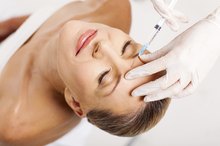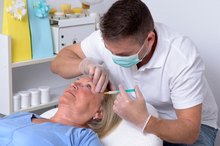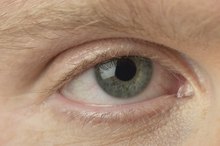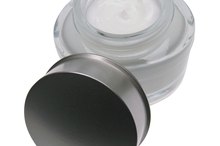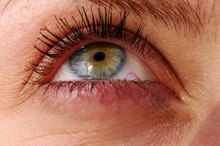Droopy Eyelids After Botox
Temporarily drooping eyelids, also known as transient ptosis, is the most commonly reported side effect of Botox according to the FDA-approved label 1. Approximately 5 percent of patients who receive Botox experience some degree of sagging in the eyelid area. This side effect, which can appear anywhere from hours to weeks after the injection, is disappointing to recipients who turned to Botox for a more youthful appearance.
Botox Basics
The active ingredient in Botox Cosmetic is onabotulinumtoxinA. The dried and purified version of this botulinum toxin is reconstituted with sterile saline and is injected into facial muscles. Over the course of about a week, the toxin binds with nerve receptors and prevents nerve impulses from reaching the muscle. This causes a temporary paralysis of that muscle which typically lasts three to four months. Ideally, only the injected muscles are affected by the toxin.
- The active ingredient in Botox Cosmetic is onabotulinumtoxinA.
- The dried and purified version of this botulinum toxin is reconstituted with sterile saline and is injected into facial muscles.
- Ideally, only the injected muscles are affected by the toxin.
Expert Insight
The Long-Term Effects of Botox
Learn More
At times the botulinum toxin spreads into neighboring muscles, resulting in unintentional paralysis. Migration to the levator palpebrae superioris muscle results in lid droop, according to Dermatology Online Journal 2. Botox Cosmetic recommends certain precautions be taken to reduce the possibility of this. Injections near the levator palpebrae superioris should be avoided. Lateral corrugators injections should be placed at least 1 centimeter above the bony supraorbital ridge. Injections should not be closer than 1 cm above the central brow. Also, the recommended dose size and frequency of administration should not be exceeded.
- At times the botulinum toxin spreads into neighboring muscles, resulting in unintentional paralysis.
- Lateral corrugators injections should be placed at least 1 centimeter above the bony supraorbital ridge.
Treatment
While drooping eyelids are bothersome, they are not permanent. The transient ptosis caused by Botox Cosmetic lasts from a few weeks to several months. Report the adverse reaction to your health care provider and discuss treatment possibilities. Several types of eye drops have been found to be effective in the treatment of transient ptosis. However, this is an unlabeled use of the eye drops, so talk to your doctor about potential complications.
- While drooping eyelids are bothersome, they are not permanent.
- Several types of eye drops have been found to be effective in the treatment of transient ptosis.
Prevention
Botox for Under Eye Wrinkles
Learn More
Proper administration of Botox Cosmetic is essential. You should seek a board certified dermatologist, plastic surgeon or cosmetic surgeon. Ask Botox providers for references, before and after photos and information about their professional licenses 3. An experienced professional can help to minimize the likelihood of eyelid drooping. Ultimately, however, you must understand that side effects are a possibility.
- Proper administration of Botox Cosmetic is essential.
- An experienced professional can help to minimize the likelihood of eyelid drooping.
Considerations
Be sure health care providers know your medical history. They need to know your medical conditions, any allergies that you have and also any medications, vitamins and herbs that you take. Side effects are more common when Botox is administered to individuals who are taking certain medications and who have specific medical conditions. A competent health care professional will ask you about your medical history. If he does not, consider it a red flag and search for a different provider.
- Be sure health care providers know your medical history.
- A competent health care professional will ask you about your medical history.
Related Articles
References
- FDA Botox Labeling
- Dermatology Online Journal
- Botox Cosmetic - Full Product Information
- Castrillo Sanz A, Morollón Sánchez-Mateos N, Simonet Hernández C, Fernández Rodríguez B, Cerdán Santacruz D, Mendoza Rodríguez A. Experience with botulinum toxin in chronic migraine. Neurologia. 2018 Oct;33(8):499-504. doi: 10.1016/j.nrl.2016.09.004. Epub 2016 Oct 21.
- Do TP, Hvedstrup J, Schytz HW. Botulinum toxin: A review of the mode of action in migraine. Acta Neurol Scand. 2018 May;137(5):442-451. doi: 10.1111/ane.12906. Epub 2018 Feb 6.
- Freund B, Rao A. Efficacy of Botulinum Toxin in Tension-Type Headaches: A Systematic Review of the Literature. Pain Pract. 2019 Feb 11. doi: 10.1111/papr.12773. [Epub ahead of print]
- Herd CP, Tomlinson CL, Rick C, Scotton WJ, Edwards J, Ives N, Clarke CE, Sinclair A. Botulinum toxins for the prevention of migraine in adults. Cochrane Database Syst Rev. 2018 Jun 25;6:CD011616. doi: 10.1002/14651858.CD011616.pub2.
Writer Bio
Journalist and medical writer Patti Kelly has been writing health and parenting articles within the health care industry since 2004. A registered nurse, she has experience as a direct care provider, medical writer and translator. Kelly holds a Bachelor of Arts in English, Spanish and French from Simpson College and is also fluent in American Sign Language.
